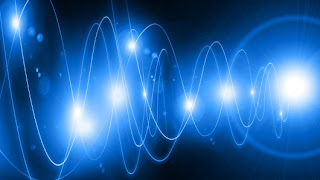 |
| Twisted light |
Light, has no mass, but does have energy and more importantly to this post, it has momentum. In fact, you can use this property of momentum to help derive Einstein's most famous equation E=mc2. A photon actually has two components of momentum. The first is one that many are familiar with, spin angular momentum, or polarisation to you and me. It is the polarisation of light that allows us to make some really clever things like 3D TVs using 3D glasses.
It also has something called orbital angular momentum, the earth going round the sun as orbital angular momentum, which some people think is a good analogy. Can't say as I do, because I can't see what the photon is orbiting!
Anyway, this property of orbital angular momentum (OAM) as got everyone in a bit of a spin because if it is in fact true, then there may be a really clever way of using this property to transmit loads of information. Which would come in very handy, mainly because we are currently running out of bandwidth.
The problem is that lots of people have lots of smart phones that can download lots and lots of information. As demand for higher definition images and faster download speeds increases the available bandwidth shrinks and shrinks and will at some point run out. May be not...
OAM potentially offers the ability to reinvigorate bandwidth, if the theories are correct there is the opportunity to tap into a massive reservoir of bandwidth which will keep us happy for at least a couple of years. Not everyone believes this is true though. Some physicists do, particularly those currently doing research in the field, others don't.
An experiment, a very public one, sent data across a Venice lagoon at a tremendous bit rate. There is little doubt about the transfer rate, up in the gigabit range. What I find really interesting is that some of the detractors think that the interpretation of the experiment is wrong. They don't think we are seeing OAM, they think we may be seeing something called Mimo, multiple input multiple output transmission. Mimo has been around since the 70s and some of the latest WiFi technologies, the 802.11n, type that you get in your latest routers exploit this technology.
So who is right, and how can anyone actually get this wrong? after all wouldn't it be obvious? Well, this is were it all gets a little human, shall we say. The Physicists involved are saying the engineers don't understand the physics. The engineers are pointing out that when it comes to telecommunications the physicists don't understand and that this is nothing more than telecommunications.
In fact the engineers go a step further and say that all the physicists did was replicate Mimo and if they try to extend their work they will realise that it does not work as expected, because it is not OAM.
We shall see.
While I feel a certain allegiance to the Physicists can't help thinking the engineers may be right on this one. Maybe that is because I haven't read that paper on Poynting's vector, I'm going to read it now and will get back to you later.



No comments:
Post a Comment